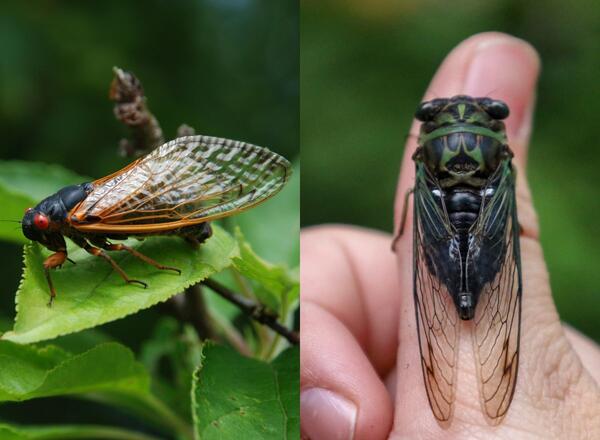
There are two species of cicadas commonly found in large numbers in Illinois. First, there are dog-day or annual cicadas that emerge every year. Second, there are periodical cicadas that emerge every 13 years in the southern half of Illinois and every 17 years in the northern half of the state.
2024 is a big year for periodical cicadas in Illinois, where Broods XIII and XIX will be emerging throughout much of the state at the same time. The simultaneous emergence is the first time since 1803 and will not happen again until 2245. Cicadas do not pose a threat to humans or pets, although newly planted trees or shrubs may be a different story.
Download the Periodical Cicada 2024 Broods of Illinois Fact Sheet.
Periodical Cicadas: 2024 Broods of Illinois
Both species of cicadas are large-bodied, have large compound eyes, and are sometimes mistakenly called locusts. Characteristics include male cicadas singing during the day to attract females. Typically, periodical cicada emergences consist of three species that can be distinguished by the male songs and by slight differences in their appearance.
Life Cycle and Biology
Periodical cicadas are among the longest-lived insects on the planet, living for 13 or 17 years. They spend most of that time living underground, feeding on tree roots. Once the soil warms enough in the spring to be 64 degrees Fahrenheit at 8 inches deep, they will begin to emerge, usually around late May or early June. The nymphs typically emerge from the soil in the evening and climb up trees or other objects and molt, leaving behind the familiar cicada shells or shed exoskeleton.
After the adults emerge, they are white and soft-bodied. They will darken and harden overnight. The periodical cicadas found in Illinois tend to be dark brown and black on top, with lighter reddish-brown patterns at the wing bases. The lower body color is similar to the wing bases. Compound eyes are red with orange major veins in the membranous wings. Contrary to popular belief, adult periodical cicadas do feed on plants, usually woody plants. However, they will spend most of their time above ground reproducing.
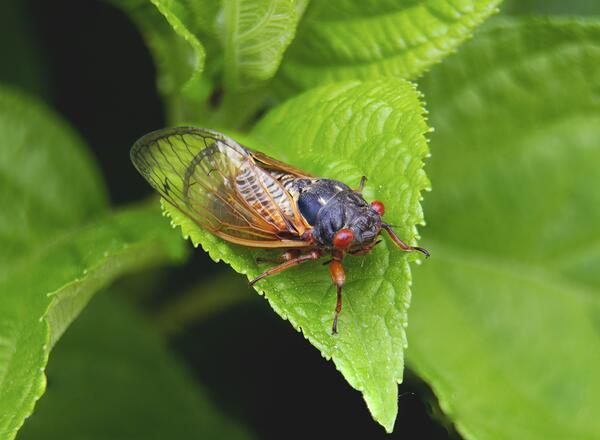
Male cicadas will start singing four or five days after they emerge. They will gather in trees and sing together to attract females. Females lack the structures known as tymbals that produce sound, so only males will sing. Each species of cicada has a distinctive song they produce.
After mating, female periodical cicadas will lay their eggs in the new growth of woody plants. They prefer branches about the width of a pencil or a little larger, up to ½ to 1-inch in diameter. They will use their saw-like ovipositor, or egg-laying organ, to cut into branches and lay 10 to 20 eggs before moving further down the branch. Each female will lay around 500 to 600 eggs.
After about a month, the adult cicadas will begin to die. Large piles of cicadas can accumulate under trees and can smell unpleasant, similar to roadkill. However, their decaying bodies will serve as fertilizer for plants.
Six to 10 weeks after they are laid, the eggs will begin to hatch. The tiny cicada nymphs will drop to the ground and begin feeding, often on grass roots. Over time, they will dig down into the soil, 8-12 inches deep, and feed on tree roots for the next 13 or 17 years.
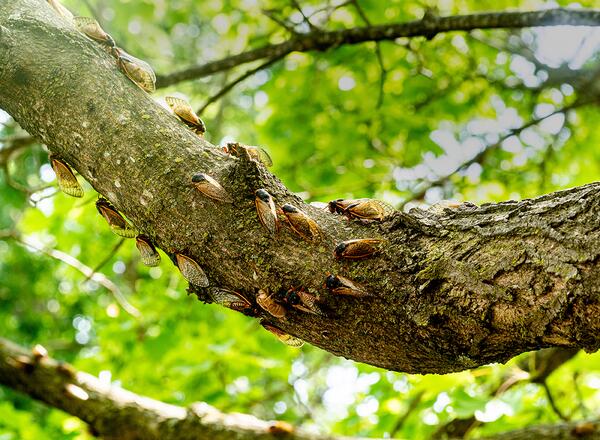
Cicada Broods
A cicada brood is a group of periodical cicadas that emerge in a given year, and there can be multiple species. There are 12 broods of cicadas with 17-year life cycles and three broods with 13-year life cycles. Each brood is assigned a Roman numeral.
For example, Brood XIII is a group of periodical cicadas that emerge every 17 years (1973, 1990, 2007, 2024, 2041, etc.), and Brood XIX is a group of cicadas that emerge every 13 years (1985, 1998, 2011, 2024, 2035, etc.).
Why do periodical cicadas come out in huge numbers every 13 or 17 years?
One theory as to why periodical cicadas emerge in 13- or 17-year intervals is because those are prime numbers or numbers that can only be divided by one and themselves.
The timing also makes it difficult for predators to evolve life cycles that would sync with the cicadas. Periodical cicadas emerging en mass overwhelm predators. In 1956, entomologists at the Field Museum estimated that as many as one million cicadas emerged per acre in a forested floodplain near Chicago, and over 130,000 emerged per acre in an upland site. Predators may eat hundreds or thousands of cicadas, but there will still be thousands left uneaten that will be able to reproduce.
Another theory is that they developed this life cycle due to the ice ages. The thought is that during this time, temperatures were colder, which slowed cicadas’ growth, extending their life cycle. Slower plant growth could also have contributed. Because of these longer life cycles, cicadas began synchronizing their emergence to find mates.
The periodical cicada flies only a short distance, less than half a mile, from where it emerges from the soil. Therefore, considering its long life cycle, it expands its territory very slowly. Only nine generations of 17-year periodical cicadas ago, Abraham Lincoln was practicing law in Illinois prior to the Civil War. During the intervening time, periodical cicadas have probably spread only about 5 miles.
There may be a few places in central Illinois, around Springfield, where the two broods will be emerging in the same area. However, overlapping is not expected to any great extent.
Depending on geographic location and the number of cicadas, it may get loud. According to the National Institutes of Health, calls of male cicadas can reach over 90 decibels. That is as loud as a lawnmower, motorcycle, or tractor.

While two broods will emerge at the same time in 2024, they won't emerge in the same place. Brood XIII, or the Northern Illinois Brood, will be emerging in the northern half of the state. Brood XIII contains all three species of 17-year periodical cicadas: Magicicada septendecim, M. cassini, and M. septendecula. In addition to Illinois, this brood will be emerging in Indiana, Iowa, Wisconsin, and possibly Michigan.
Brood XIX, also known as the Great Southern Brood, will emerge in the southern half of Illinois. The four species of cicadas in this brood are 13-year cicadas, Magicicada tredecim, M. neotredecim, M. tredecassini, and M. tredecula. This brood is the largest of the 13-year broods, geographically speaking. It will emerge across Alabama, Arkansas, Georgia, Illinois, Indiana, Kentucky, Louisiana, Mississippi, Missouri, North Carolina, Oklahoma, South Carolina, Tennessee, and Virginia.
As female periodical cicadas lay their eggs, they cut open branches with their ovipositor. This will result in a scar that can be several inches long. These damaged areas may sometimes break, which will cause everything past this damaged area to die. This is often referred to as flagging. Flagging will not kill healthy, mature trees.
Newly planted small trees and shrubs may have trunk diameters small enough for female cicadas to lay their eggs. If this happens, the trees can be killed. These smaller plants also have fewer branches on them, and egg-laying can cause significant damage to the trees.
Protect trees and shrubs from periodical cicada damage
- Avoid planting trees and shrubs the year before a periodical cicada emergence. Also, avoid planting trees and shrubs in the spring of an emergence year. If planting is necessary, choose plants that have a stem diameter of at least 2½ inches in diameter.
- Place netting around small trees and shrubs, making sure it is secured around the base of the plant to prevent cicadas from crawling up the plant from the ground. The opening should be no larger than ¼ inch. It may be helpful to build a frame around the plants as cicadas may still be able to lay eggs on branches touching the netting.
- Twigs and branches with eggs laid in them can be pruned off to prevent the nymphs from reaching the ground and feeding. However, feeding by cicada nymphs does not seem to be harmful to the trees they feed on.
- Insecticides are not recommended to manage periodical cicadas. Large, healthy trees can survive egg-laying with no long-term impacts. This has been happening for thousands of years. Insecticides are less effective in protecting smaller trees and shrubs from cicadas than netting. Additionally, applying pesticides to control cicadas may harm other organisms, including animals that eat cicadas.
- Cicada killer wasps won’t be of any help. They emerge later in the year when annual or dog-day cicadas emerge, and by that time, periodical cicada adults will be dead.
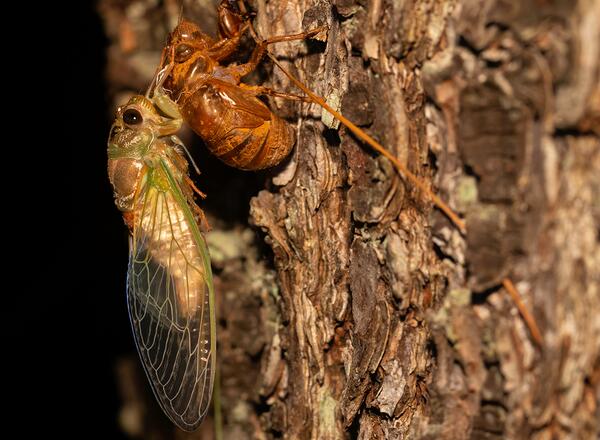
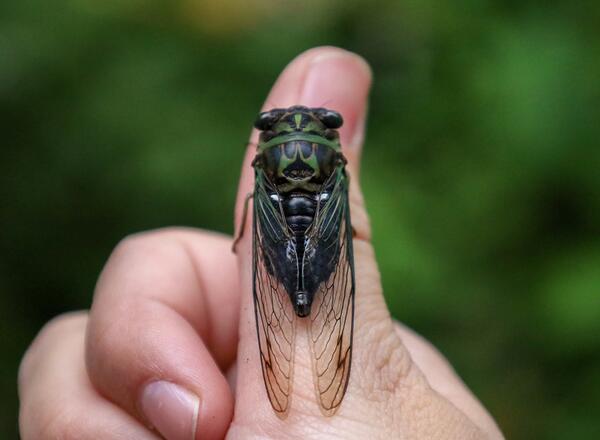
Annual or dog-day cicadas, Neotibicen canicularis, appear every summer, usually July through September in Illinois. It typically takes 2 to 5 years to complete their development and they have overlapping generations and are not synchronized. On the other hand, periodical cicadas take 13 or 17 years to complete their development from egg to adult, and they emerge in mass in the spring.
There are many species of dog-day cicadas. Dog-day cicadas emerge from the soil during the heat of the summer or the dog days of summer. They are also known as harvest flies, and that name came about because various crops were being harvested at the time of their emergence.
They also look different in appearance. Annual cicadas are about 1½ to 2½ inches long and have a green and brown pattern to green and black pattern with a primarily white underside. Periodical cicadas are smaller, around ¾ to 1½ inches long. They have black bodies with orange wing veins and red eyes.
Once they emerge, they mate and lay eggs. The eggs hatch, and the nymphs feed on the sap in trees and shrub roots for two to five years. When fully grown, the nymphs emerge from the soil, climb a tree, building, or other upright object, and shed the exoskeleton that protects their body and wings while tunneling up through the soil. The thorax swells and splits the exoskeleton by pumping body fluids to the thorax area behind the head. The action allows the adult to emerge. Once free, fluids are pumped into their wings, causing them to unfold and expand. Once the wings are fully extended, cicadas allow time for the wings to dry out before taking flight.
Wildlife aren’t the only things that can eat cicadas; humans can too. Anyone allergic to shellfish should avoid eating them. As such, cicadas should also be treated as any other potential allergen when preparing food for the public.
Historically, Native Americans used them in their diet. In 1990, several college students were filmed eating them alive. When asked what they tasted like, the students reported that they tasted like almonds. Drying them in a microwave oven carefully causes them to release an almond smell.
Those curious to try one, should collect adults after they have molted, but before they harden and while they are still white. Explore these considerations before eating a cicada.
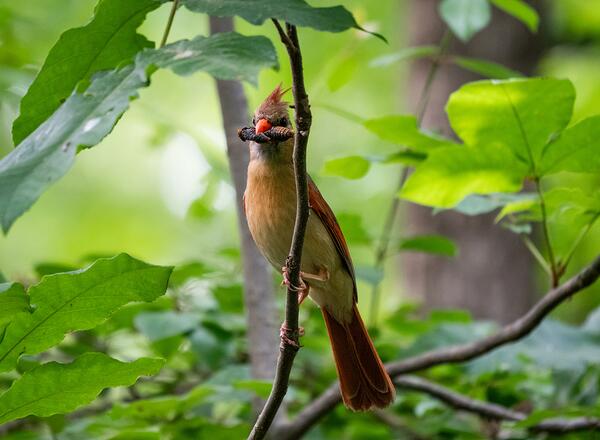
The arrival of periodical cicadas can be a boon for both wildlife and livestock species that will feast on the smorgasbord of insects.
Raccoons, opossums, coyotes, snakes, and fish will all prey on cicadas. Domestic poultry and a variety of wild birds – including bluebirds, cardinals, woodpeckers, and raptors – alike will eat cicadas, and many species will increase in population in the years following. One study found that some birds will leave the area during an emergence, which could be related to the loudness of cicada calls.
The occasional superabundance of a species, such as cicadas or migrating salmon, is known as a “resource pulse” that can have wide-ranging impacts on the ecosystem. A study during an emergence of Brood X found that when 80 species of birds added periodical cicadas to their diet, forest caterpillar populations increased due to the lack of predation. The caterpillars, in turn, then foraged heavily on oak tree leaves. While cicadas will eat tree leaves, research shows it can be a mutually beneficial relationship because when adult periodical cicadas die, their bodies fertilize the soil with nitrogen and boost the growth of surrounding trees in the years following an emergence.
Note: Some of this information previously appeared on Extension's Cicadas in Illinois website, written by James Schuster and Philip Nixon.
- Cooley, John. 2017. “General Periodical Cicada Information | Cicadas.” Cicadas.uconn.edu. 16 February 2017. https://cicadas.uconn.edu.
- Getman-Pickering, Z. L., Soltis, G. J., Shamash, S., Gruner, D. S., Weiss, M. R., & Lill, J. T. (2023). Periodical cicadas disrupt trophic dynamics through community-level shifts in avian foraging. Science. https://doi.org/adi7426
- Hughson, S. (2024). “Periodical cicadas of brood XIII and brood XIX emerge at same time!” Pesticide News. Illinois Extension. 9 February 2024. https://extension.illinois.edu/blogs/pesticide-news/2024-02-09-periodical-cicadas-brood-xiii-and-brood-xix-emerge-same-time
- Koenig, W. D., & Liebhold, A. M. (2005). Effects of periodical cicada emergences on abundance and synchrony of avian populations. Ecology, 86(7), 1873-1882. https://doi.org/10.1890/04-1175
- Koenig, W. D., Ries, L., K. Olsen, V. B., & Liebhold, A. M. (2011). Avian predators are less abundant during periodical cicada emergences, but why? Ecology, 92(3), 784-790. https://doi.org/10.1890/10-1583.1
- Kritsky, Gene. 2024. A Tale of Two Broods: The 2024 Emergence of Periodical Cicada Broods XIII and XIX. Columbus, OH: Ohio Biological Survey.
- Kritsky, Gene. 2004. Periodical Cicadas the Plague and the Puzzle. Indiana Academy of Science.
- Simon, C., J. R. Cooley, R. Karban, & T. Sota. (2022). Advances in the Evolution and Ecology of 13-and 17-Year Periodical Cicadas. Annual Review of Entomology, 67(1), 457-482. https://doi.org/10.1146/annurev-ento-072121-061108
- Speer, J. H., Clay, K., Bishop, G., & Creech, M. (2010). The Effect of Periodical Cicadas on Growth of Five Tree Species in Midwestern Deciduous Forests. The American Midland Naturalist, 164(2), 173-186.
- Wahle, E. (2024). Considering eating a periodical cicada? Commercial Fruity and Vegetable Growers. Illinois Extension. 20 February 2024. https://extension.illinois.edu/blogs/commercial-fruit-and-vegetable-growers/2024-02-20-considering-eating-periodical-cicada
- Yang, L.H. (2004). Periodical Cicadas as Resource Pulses in North American Forests. Science, 306(5701), 1565-1567. 10.1126/science.1103114.
- Yang, L. H., & Karban, R. (2019). The effects of pulsed fertilization and chronic herbivory by periodical cicadas on tree growth. Ecology, 100(6), e02705. https://doi.org/10.1002/ecy.2705
- Yoshimura, Jin. 1997. “The Evolutionary Origins of Periodical Cicadas during Ice Ages.” The American Naturalist 149 (1): 112–24. https://doi.org/10.1086/285981.
- Additional resource sites: Cicada Mania, Cicada Safari
Photos: Adobe Stock